As a railroad worker and a train enthusiast I remember how strongly I wanted to know what the parts of a train are and how they are all interconnected.
Now I will run through all major and most minor parts of a train and include photos.
How do trains operate?
These days, a train is a combination of locomotives and cars. In the past there was a third car, called caboose, attached at the end of a freight train, which stopped being used once the radio communications began to be implemented.
So what are the parts of a train? Simple: Locomotives and Cars.
As there are different types of locomotives and cars, go into the main details.
Parts Of A Train -Locomotive
As mentioned above I will go in depth on locomotive components, and I will analyze diesel-electric locomotive parts, diesel-mechanical, as well as the steam locomotive parts.
Parts Of A Diesel-Electric Locomotive
The Diesel-Electric Locomotive has over 27 major parts that contribute in harmony to its operation.
I also recommend you to read what is a locomotive consist to understand things better.
Please check the scheme created below for a general idea of where the parts are situated, note: this is for a general purpose only.
Alternator
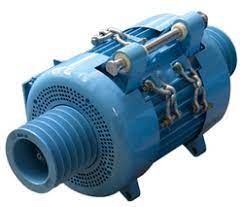
The alternator generates AC electricity, used to power the traction motors. The Main Alternator is powered by the Diesel Engine. That’s why the locomotive it’s called Diesel-Electric Locomotive.
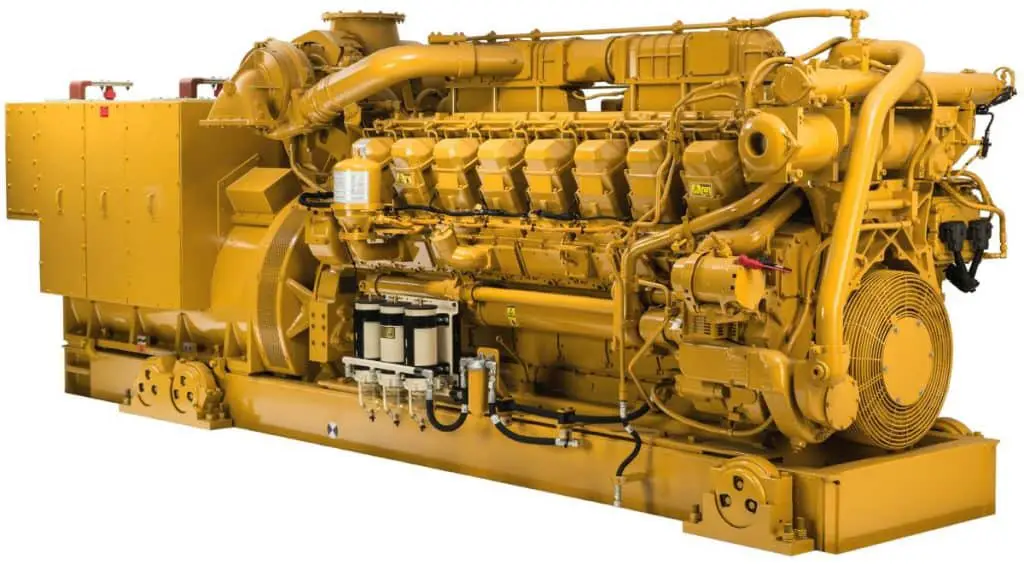
Diesel Engine
This type of locomotive it’s powered by the diesel engine, which powers the AC alternator. The diesel engine cylinders might be arranged in V or inline, where the engine engages the drive shaft for various tasks, including the most important, powering the alternator which produces the electrical energy to power the train.
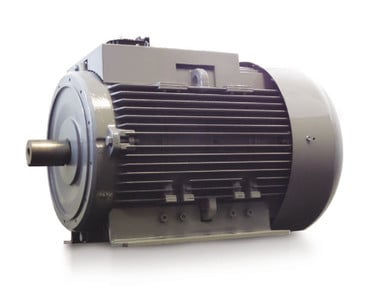
Auxiliary Alternator
– it’s mainly used to power auxiliary electrical sources, like the interior car lights, outlets, air conditioning, dining appliances. The majority of passenger train locomotives are equipped with this extra alternator, where the freight locomotive doesn’t need it.
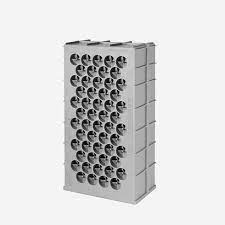
Air Intakes
This part is used for cooling the locomotive, the air is drawn inside the locomotive through these intakes, reaching the engine and other parts that need cooling, after passing through various filters and temperature regulators.
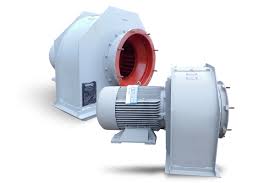
Motor Blower
As the name states, the motor blower blows air over the traction motors, keeping them cool. The cooling system is way more complex, especially for the newer locomotives.
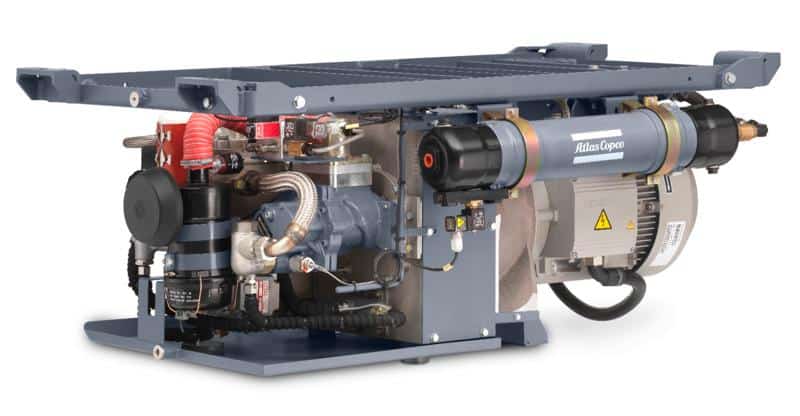
Rectifiers/ Inverters.
Rectifiers are used to convert the electricity from the main alternator from DC to AC.
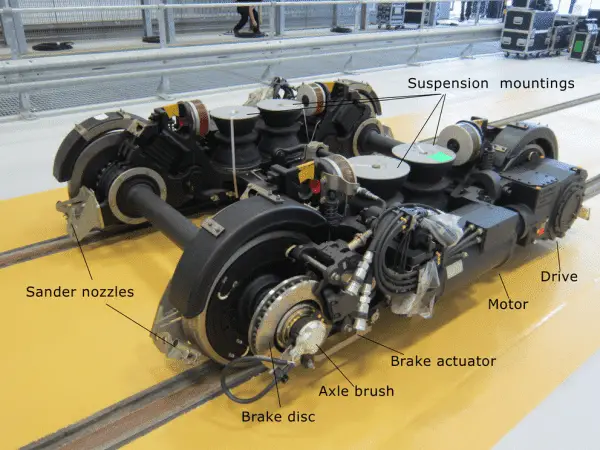
Truck
A truck, or also called bogie, is a frame, placed under the trains, onto which the wheels of the railway vehicle are fixed.
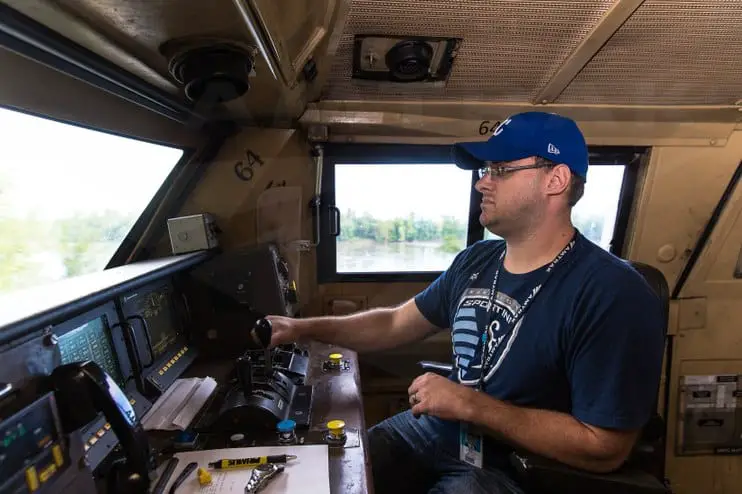
Control Station
The area from which the locomotive engineer operates the locomotive/train. In the United States, it is positioned in an angle on the left side.
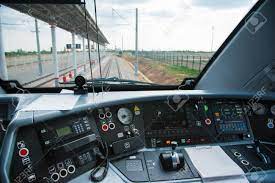
Cab
Most of the locomotives in the United States have just one cab, at one end.
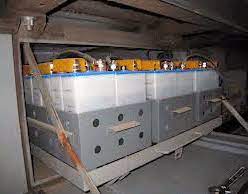
Batteries
This train part is needed for the diesel engine to start, exactly as an automobile.
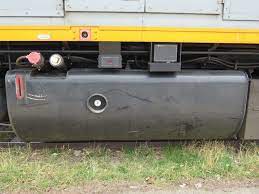
Fuel Tank
Usually two tanks, on each side of the locomotive. The total capacity is around 5,000 gallons of fuel.
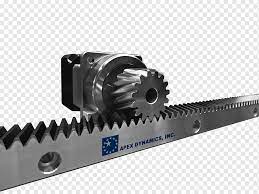
Rack & Pinion
The gear has a reduction of 3 to 1 for freight and 4 to 1 for passenger trains, engaged by the traction motor.
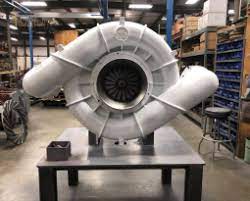
Turbo Charger
Used to increase the capacity of pushing air into the cylinders faster, delivering up to 50% more power. Works like any other turbo charging system.
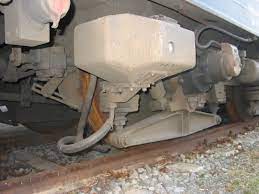
Sand Box
Always carried by the locomotives to provide assistance with adhesion on bad rail conditions.
Stirrup
The stirrup it’s a ring, metal loop, that operates as a step to get into the locomotive.
Electronic Controls
In most of the cases it is situated in the cab, for easy access. It provides few types of electronic control and data management access for different devices.
Air Reservoirs
Required for brakes and other systems around the train, the reservoir contains compressed air.
Ventilator
Fans that cool the traction motors.
Radiator and Radiator Fan
The diesel engine is liquid cooled, the radiator works as any other vehicle radiator. The liquid passes through the engine to cool it down, reaching the radiator and the fan, cooling the liquid and moving back to the engine, into a continuous cycle.
Drive Shaft
Used to transmit the power from the diesel engine to the alternator, air compressor and radiator fans.
Gear Box
This locomotive part is used to change the direction to the drive shaft, upwards toward the radiator fan.
Air Compressor
This train part provides a continuous supply of compressed air for the train brakes, being powered by the diesel engine.
Traction Motors
As the name states, the diesel-electric locomotives use electricity to power the train. The alternator is powered by the diesel engine, and the traction motors are powered by the alternator.
Porthole windows
Windows on the train.
Headlights
Lights at the front of the locomotive, illuminating the track.
Horn
The train crew is required, under federal laws, to sound the horn when getting close to a road crossing, for protection and safety.
Safety Rail
Used to prevent falls/ provide safety.
Water Tank
Tank for the cooling water
Coupler Head
Gadget at the end of locomotives, used to connect/ attach other locomotives or cars.
Pilot
Mechanism found at the front of the locomotive used to divert obstacles/litter from the track that might otherwise damage or derail the train.
Numberboards Wheels
A plaque attached to the side of the locomotive or just a painted number on the side of the locomotive. Used to identify the locomotives.
Wheels
AAR wheel arrangement – Used largely throughout the US and Canada for diesel and electric locomotives.
Side Footboard
Ladder used for climbing up or down from the locomotive.
Parts Of A Train – Diesel Mechanical Locomotive
A diesel-mechanical locomotive has a direct mechanical link between the diesel engine and the wheels instead of electric transmission. The transmission is similar to that of an automobile with a four speed gearbox.
Cab
Most of the locomotives in the United States have just one cab, at one end.
Numberboard
A plaque attached to the side of the locomotive or just a painted number on the side of the locomotive. Used to identify the locomotives.
Ventilator
Fans that cool the traction motors.
Horn
The train crew is required, under federal laws, to sound the horn when getting close to a road crossing, for protection and safety.
Fuel Tank
Usually two tanks, on each side of the locomotive. The total capacity is around 5,000 gallons of fuel.
Final Drive
The diesel-mechanical locomotive uses a final drive similar to that of a steam engine.
Coupler Head
Gadget at the end of locomotives, used to connect/ attach other locomotives or cars.
Porthole Windows
Windows on the train.
Truck
A truck, or also called bogie, is a frame, placed under the trains, onto which the wheels of the railway vehicle are fixed.
Headlights
Lights at the front of the locomotive, illuminating the track.
Fluid Coupling
In a diesel mechanical transmission, the fluid coupling’s role is to transmit power from the engine to the drive train. The coupling is made of two sets of discs with blades and a case filled with oil.
One set of blades it’s connected to the engine and it’s called an impeller( or the pump) and the other one, called the turbine, it’s connected to the drive train.
Stirrup
The stirrup it’s a ring, metal loop, that operates as a step to get into the locomotive.
Fuel Tank
Usually two tanks, on each side of the locomotive. The total capacity is around 5,000 gallons of fuel.
Gear Box
This locomotive part is used to change the direction to the drive shaft, upwards toward the radiator fan.
Pilot
Mechanism found at the front of the locomotive used to divert obstacles/litter from the track that might otherwise damage or derail the train.
Wheels Bell
AAR wheel arrangement – Used largely throughout the US and Canada for diesel and electric locomotives.
Parts Of A Train – Diesel Hydraulic Motors
Diesel-hydraulic locomotives are very similar to the mechanical ones, except they have a torque-converter instead of a gearbox, in order to transport the power to the wheels.
Parts Of A Train – Steam Locomotive
The steam engine was invented in the late 1700’s as part of the foundation of the Industrial Revolution.
The first steam locomotive was developed in the early 1800’s. The first use was to carry goods on tramways in the place of horses.
Let’s get to know the parts of a steam locomotive:
Bell
Their purpose was to make noise, alerting people and animals of an oncoming train.
Cab
The cab is the crew compartment.
Drivers
The drivers are the wheels that support the weight of the locomotive
Headlamp
The main purpose of the headlamp is that it can warn people on the track ahead of an approaching train, with sufficient time for them to take action.
Trailing truck
The wheel unit that helps support the weight.
Pilot
Mechanism found at the front of the locomotive used to divert obstacles/litter from the track that might otherwise damage or derail the train.
Steam Dome
It’s found at the top of the boiler of a steam engine.
Drive Rod Smoke Stack
Transfer the power of drive to all wheels.
Smoke Stack
The part of a steam locomotive where smoke leaves the boiler.
Whistle Sand Dome
Device used to warn that the train is approaching.
Sand Dome
Steam engines used high-grade silica sand for traction on the rails. Sand was stored in a dome on top of the engine.
Steam Chest
A compartment in a steam engine through which steam is delivered from the boiler to a cylinder.
Pilot truck
Provide guidance for the locomotive into the curve
Ashpan
Mounted underneath the firebox and below the grates, having the role to catch and collect ashes, and other solid combustion waste as it falls through the grates.
Classification Lights
Lights that are green, white or red, helping to identify the train.
Valve Gear
Valve gear is used to control the admission of steam into the cylinders of the locomotive.
Eccentric Crank and Rod
A rod connects the rear end of the piston rod to a crank pin on the driven wheel. The wheel is attached to an axle.
Diesel locomotives are more convenient than steam locomotives. It takes hours to fire up a steam engine before using it, compared to the diesel one that can get running in less than a minute.
Electricity was way more convenient, who would want to load coal in a factory every day when you can just use switches to make it work?
Parts Of A Train – Passenger Car
Passenger cars are broadly used throughout the world. There are many differences between the passenger cars (bullet speed trains vs. regular passenger trains). For this article, we will evaluate the regular passenger cars we see hauled by AmTrak.
I was able to list over 20 parts of a train car, let’s take a closer look.
Doors
Doors allow passengers to gain access and leave the Passenger Train.
Bogie
A bogie is a structure underneath a railway vehicle body to which axles and wheels are attached through bearings
Wheels
Passenger car wheels- Manufacturing standards TB/T 2817/2708, AAR M-107, BS 5892-3 and EN 13262 are met in the manufacturing process.
Air Conditioning Condenser
The outdoor portion of an air conditioner or heat pump that either releases or collects heat, depending on the time of the year.
Auxiliary Inverter
The auxiliary power supply (static inverter) converts the power for interior light, displays, air conditioning, etc.
Brake Frame
An assembly rack for train brake control equipment mounted under or inside a vehicle.
Toilet Retention Tank
Passenger trains have toilet facilities, usually at the end of the car. They come with retention tanks that need to be emptied regularly.
Suspension Air Bag
An air bag suspension system for railway vehicles is one which the wheel supporting axles are vertically able to slide. They are connected to longitudinal support beams with an air bag disposed between the top portion of the axle and a corresponding portion of the beam.
Tumblehome
Tumblehome is the inward curve of the lower body panel.
Dome
The three dimensional part which forms the end of the roof where it meets the body end.
Drawbar
Two or more passenger cars may be attached with a drawbar.
Sole Bar
Longitudinal beams running along sides of a car, onto which the bodywork is mounted, in passenger-carrying trains usually forming the side or the base of the floor.
Waist Rail
Horizontal piece in the framing of the side of a passenger-car.
Cant Rail
The rate of change in height between the two rails or edges.
Light Indicator
Train signals to prevent accidents and inform drivers of when the track ahead is clear.
Roof
The top part of a car
Gangway Bellows
Flexible connector fitted at the end of a car, allowing passengers to move from one coach to another without danger of falling from the train.
Parts Of A Train – Freight Car
A freight train or cargo train is a group of freight cars pulled by one or more locomotives, transporting cargo.
Before steel cars were introduced in 1896, they used to be made of wood and traveled on tramways pulled by horses or mules, carrying coal or quarried stone. Within 30 years, steel cars had almost completely replaced the wooden variety.
There are so many different types of freight cars that are used to transport goods. Will go over some examples( the most common in today’s railway) and talk about each one.
Autorack
An autorack is specialized in transporting cars, trucks and SUVs. Freight rail moves nearly 75% of the new cars and light trucks purchased in the U.S. each year, according to the Association of American Railroads (AAR).
Autoracks are entirely enclosed and made of metal. There are two types of autoracks: bi-level, which has two levels and can be used for any vehicle type, and tri-level, which has three levels and is usually used for smaller passenger vehicles.
Covered Hopper
A covered hopper is an enclosed car with fixed roof, sides, and ends, with openings for loading through the roof and bottom openings for unloading.
These types of cars are designed to carry dry bulk loads, from corn, wheat, barley, to products such as cement, sand and clay. The top is then covered to protect the contents inside.
For example, dry cement would be hard to unload if mixed with water in transit, or grain would be likely to rot if rain would get inside. The bottom of a covered hopper has chutes (“gates”) that can be opened to unload the product.
Covered hoppers come in three types: small, large and food-grade.
Open-top Hopper
Open-top hoppers look just like covered hopper cars, with fixed sides and ends, but they don’t have a roof. They werevdesigned specifically to be loaded and unloaded easily, with wide open tops for loading and gates at the bottom for unloading.
Because these cars don’t have a roof, they are suited for freight that is not affected by the weather like: coal, wood chips, ballast, rocks etc.
There are two types of Open-top hoppers: Large and Small Open-Top Hopper.
Well Car (Container Car)
A well car is a type of railroad car that carries shipping containers. Because they are designed to ride lower than flatcars, it allows to carry a stack of two containers per unit on railway lines (double stack).
Gondola
Gondolas, often referred to as “gons” have fixed bottoms, low side walls and open tops. Used since the earliest years of industry, 1800, it has a multitude of uses.
It carries raw materials used for building roads, skyscrapers like lumber, steel, sand, scrap metal and much more. According to the Association of American Railroads (AAR), in a year, U.S. freight railroads transport more than two million carloads of construction-related materials.
Because of the way the gondolas are designed and structured, loading and unloading it’s pretty easy, usually done with the help of cranes. Backhoes can also be used or even a claw or magnet when loading and unloading steel.
There are two types of gondolas: side-dump style and simple “bathtub” style.
Boxcar
Boxcars look like a box, really. Rectangular in shape, completely enclosed, and has sliding doors or plug doors on the sides. They are one of the oldest rail car types.
Boxcars are very adaptable and can carry almost any kind of freight. Because they are enclosed, boxcars are used to carry loads that require protection from the weather like paper, grains, canned goods, beverages, flour etc.
Their interior size is about between 50 feet and 60 feet long with a minimum width of 9 feet inside. In the beginning, boxcars were loaded and unloaded by hand. Nowadays, they are unloaded by forklifts or other mechanical devices.
Refrigerated Boxcar
Refrigerated boxcars (“reefers”) are pretty much like traditional boxcars but heavily insulated and temperature controlled.
They carry perishable freight, like fresh fruits, vegetables, frozen food, beverages, meat, poultry, seafood and cheese but also nonperishable items, like canned and boxed foods.
According to the Association of American Railroads (AAR), railroads ship approximately 65,000 carloads of fresh fruits and vegetables and 74,000 carloads of meat and poultry products yearly.
Coil Car
Coil cars are specifically designed to carry products like coiled steel, steel plate or high-grade ores. In 2019, railroads moved nearly 569,000 carloads of steel and other primary metal products, according to the Association of American Railroads (AAR).
Coil cars have different lengths, tonnage and capacities being able to carry loads up to approximately 200,000 pounds.
Overhead cranes or forklifts are used for loading and unloading steel coils from coil cars.
Tank Car
A tank car is a type of railroad car designed to transport liquid and gaseous commodities, being able to hold between 6,500 gallons to more than 31,000 gallons.
Many chemicals are considered hazardous materials and rail is one of the safest modes of transportation for transporting hazardous substances. According to AAR , 99.99% of all hazardous materials moved annually by rail reach its destination without a release caused by a train accident.
There are two different types of rail tank cars: pressurized(used for compressed gasses, keeping the material under pressure and in the liquid form) and non-pressurized( for all other types of liquid materials)
Loading and unloading for the pressurized cars is done through secure valves while non pressurized tanks have an outlet at the bottom, where the liquid is transferred safely.
Flatcar
Flatcars were the first type of railcar used by the railroad industry.
Flatcars are flat, horizontal floors without sides or roof. They vary in lengths, tonnage and capacities and because of their open design it allows to accommodate all kinds of freight.
Basically, oversized and strangely shaped that cannot be transported on other types of cars. It carries pipes, tractors, lumber, oversized machinery, military equipment and so on.
Cranes and forklifts are, in general, used to load and unload freight. Unless the freight consists of military or construction equipment, it can be driven on and off.
There are different types of flat cars like: Plain Flatcar, 89-Foot Pipe Flatcar, Bulkhead Flatcar, 89-Foot Log Flatcar, Specialized Flatcar.
Centerbeam
Centerbeams are flat cars, reinforced by a longitudinal I-beam truss down the center of the railcar, allowing products to be secured in place.
Usually 73 feet long, a centerbeam flatcar can carry about 200,000 pounds of freight, and that is wallboard, lumber, or other building supplies.
One centerbeam rail car can carry enough framing lumber to build about six homes. Definitely a more efficient and cost-effective shipping option compared to trucks. A single train can carry as much freight as 300 trucks.
Due to their design, centerbeam cars must be loaded symmetrically, with equal payload on each side of the partition.
Intermodal Equipment
An intermodal container, or often called a shipping container, look like large, rectangular boxes made of rust-retardant Corten steel, with doors at one end that can be sealed and locked.
While their width is 8 feet, the length and height may vary, depending on the container type. Container length can range from 20 to 53 feet and container height can range from 8 feet to 10 feet 6 inches.
Intermodal equipment can travel by land or by sea, and can carry just about anything.
Intermodal containers and trailers are loaded and unloaded through double doors at the back end of the container or trailer.Containers can be transferred between ships, trains and trucks without unloading or reloading the cargo.
Stock Car
A stock car is a type of car which is used to transport cattle, sheep, and other livestock.
More information including graphs of each car is coming soon.
Conclusion
Trains are becoming more minimal in design but with more complex insides. I hope I have help you gain an understanding of these awesome machines.
How long is train? Find out HERE.
